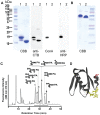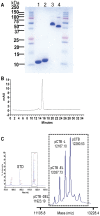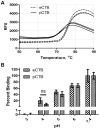Rapid and scalable plant-based production of a cholera toxin B subunit variant to aid in mass vaccination against cholera outbreaks
- PMID: 23505583
- PMCID: PMC3591335
- DOI: 10.1371/journal.pntd.0002046
Rapid and scalable plant-based production of a cholera toxin B subunit variant to aid in mass vaccination against cholera outbreaks
Abstract
Introduction: Cholera toxin B subunit (CTB) is a component of an internationally licensed oral cholera vaccine. The protein induces neutralizing antibodies against the holotoxin, the virulence factor responsible for severe diarrhea. A field clinical trial has suggested that the addition of CTB to killed whole-cell bacteria provides superior short-term protection to whole-cell-only vaccines; however, challenges in CTB biomanufacturing (i.e., cost and scale) hamper its implementation to mass vaccination in developing countries. To provide a potential solution to this issue, we developed a rapid, robust, and scalable CTB production system in plants.
Methodology/principal findings: In a preliminary study of expressing original CTB in transgenic Nicotiana benthamiana, the protein was N-glycosylated with plant-specific glycans. Thus, an aglycosylated CTB variant (pCTB) was created and overexpressed via a plant virus vector. Upon additional transgene engineering for retention in the endoplasmic reticulum and optimization of a secretory signal, the yield of pCTB was dramatically improved, reaching >1 g per kg of fresh leaf material. The protein was efficiently purified by simple two-step chromatography. The GM1-ganglioside binding capacity and conformational stability of pCTB were virtually identical to the bacteria-derived original B subunit, as demonstrated in competitive enzyme-linked immunosorbent assay, surface plasmon resonance, and fluorescence-based thermal shift assay. Mammalian cell surface-binding was corroborated by immunofluorescence and flow cytometry. pCTB exhibited strong oral immunogenicity in mice, inducing significant levels of CTB-specific intestinal antibodies that persisted over 6 months. Moreover, these antibodies effectively neutralized the cholera holotoxin in vitro.
Conclusions/significance: Taken together, these results demonstrated that pCTB has robust producibility in Nicotiana plants and retains most, if not all, of major biological activities of the original protein. This rapid and easily scalable system may enable the implementation of pCTB to mass vaccination against outbreaks, thereby providing better protection of high-risk populations in developing countries.
Conflict of interest statement
I have read the journal's policy and have the following conflicts: KTH and NM have filed a patent application concerning the findings described in this paper (International Patent Application No. PCT/US12/29072).
Figures








Similar articles
-
N-glycosylation of cholera toxin B subunit in Nicotiana benthamiana: impacts on host stress response, production yield and vaccine potential.Sci Rep. 2015 Jan 23;5:8003. doi: 10.1038/srep08003. Sci Rep. 2015. PMID: 25614217 Free PMC article.
-
Studies on the immunogenic potential of plant-expressed cholera toxin B subunit.Plant Cell Rep. 2004 Feb;22(7):471-7. doi: 10.1007/s00299-003-0711-9. Epub 2003 Sep 27. Plant Cell Rep. 2004. PMID: 14517689
-
Recombinant cholera toxin B subunit and gene fusion proteins for oral vaccination.Res Microbiol. 1990 Sep-Oct;141(7-8):971-9. doi: 10.1016/0923-2508(90)90137-f. Res Microbiol. 1990. PMID: 2101488
-
Cholera toxin B: one subunit with many pharmaceutical applications.Toxins (Basel). 2015 Mar 20;7(3):974-96. doi: 10.3390/toxins7030974. Toxins (Basel). 2015. PMID: 25802972 Free PMC article. Review.
-
Mucosal vaccines based on the use of cholera toxin B subunit as immunogen and antigen carrier.Dev Biol Stand. 1994;82:215-27. Dev Biol Stand. 1994. PMID: 7958476 Review.
Cited by
-
Repeated Oral Administration of a KDEL-tagged Recombinant Cholera Toxin B Subunit Effectively Mitigates DSS Colitis Despite a Robust Immunogenic Response.Toxins (Basel). 2019 Nov 20;11(12):678. doi: 10.3390/toxins11120678. Toxins (Basel). 2019. PMID: 31756977 Free PMC article.
-
Control of foreign polypeptide localization in specific layers of protein body type I in rice seed.Plant Cell Rep. 2016 Jun;35(6):1287-95. doi: 10.1007/s00299-016-1960-8. Epub 2016 Feb 24. Plant Cell Rep. 2016. PMID: 26910860 Free PMC article.
-
Pharmacokinetics and Safety Studies in Rodent Models Support Development of EPICERTIN as a Novel Topical Wound-Healing Biologic for Ulcerative Colitis.J Pharmacol Exp Ther. 2022 Mar;380(3):162-170. doi: 10.1124/jpet.121.000904. Epub 2022 Jan 20. J Pharmacol Exp Ther. 2022. PMID: 35058349 Free PMC article.
-
DNA Virus Vectors for Vaccine Production in Plants: Spotlight on Geminiviruses.Vaccines (Basel). 2014 Aug 5;2(3):642-53. doi: 10.3390/vaccines2030642. Vaccines (Basel). 2014. PMID: 26344750 Free PMC article. Review.
-
Therapeutic Potential of Cholera Toxin B Subunit for the Treatment of Inflammatory Diseases of the Mucosa.Toxins (Basel). 2017 Nov 23;9(12):379. doi: 10.3390/toxins9120379. Toxins (Basel). 2017. PMID: 29168738 Free PMC article. Review.
References
-
- Cholera, 2011. Wkly Epidemiol Rec 87: 289–304. - PubMed
-
- Clemens JD, Sack DA, Harris JR, Chakraborty J, Khan MR, et al. (1986) Field trial of oral cholera vaccines in Bangladesh. Lancet 2: 124–127. - PubMed
-
- Clemens JD, Harris JR, Sack DA, Chakraborty J, Ahmed F, et al. (1988) Field trial of oral cholera vaccines in Bangladesh: results of one year of follow-up. J Infect Dis 158: 60–69. - PubMed
-
- van Loon FP, Clemens JD, Chakraborty J, Rao MR, Kay BA, et al. (1996) Field trial of inactivated oral cholera vaccines in Bangladesh: results from 5 years of follow-up. Vaccine 14: 162–166. - PubMed
-
- Jertborn M, Svennerholm AM, Holmgren J (1992) Safety and immunogenicity of an oral recombinant cholera B subunit-whole cell vaccine in Swedish volunteers. Vaccine 10: 130–132. - PubMed
Publication types
MeSH terms
Substances
LinkOut - more resources
Full Text Sources
Other Literature Sources

